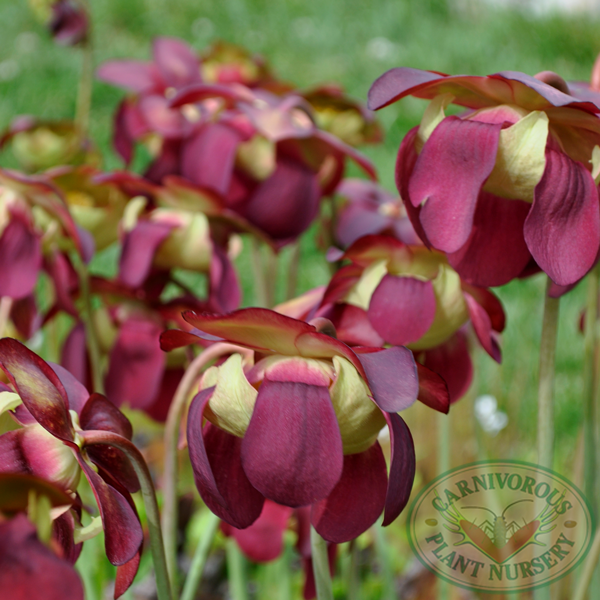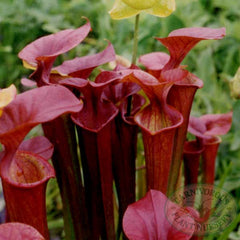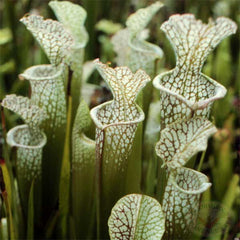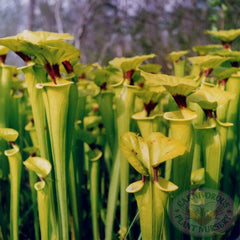
Growing Tips for Sarracenia



Sarracenia, American Pitcher Plants
Soil: 5:1 peat:sand.
Container: 4" plastic pot.
Watering: moist to wet.
Light: full to part sun.
Temperature: warm summer, cool winter-tolerates frost.
Humidity: medium.
Location: outdoors, windowsill, terrarium, greenhouse.
Dormancy: required of northern species, winter rest for southern species.
Habitat
Most American Pitcher Plants grow naturally in the bogs, pocosins and fens of the coastal plains of eastern N. America, from New Foundland to Florida, with greater numbers in the southeast. They typically grow among the sedges in the open sun, where the moist soil is typically a sand/peat mix, usually dominated by sand. The climate is generally warm temperate, except for S. purpurea purpurea, the Northern Purple Pitcher Plant, that survives freezing Winters. Summers are hot and humid and Winters are generally mild with occasional cold spells and even light frosts. Rainfall is about 8”/month (20cm) in the Summer and 5”/month (12cm) in the Winter. A common companion Carnivorous Plant is Drosera intermedia and Drosera filiformis.
Culture
The American Pitcher Plants are fairly tolerant of general Carnivorous Plant growing conditions. A standard Carnivorous Plant soil mix of peat and sand works well. I find that they grow better, when the peat content is higher. Mature Pitcher Plants prefer a deeper large pot of 6-8” (15-20cm) because of their long roots. Most pitcher plants do best when the soil is evenly moist, but not soaking wet. They can tolerate very wet, even submerged conditions, for weeks at a time. Let the soil become drier; yet remain somewhat moist, during winter dormancy. Water from below with mineral-free water. The tray method works very well. Stand the pot in a tray or saucer and keep about 1” (2.5cm) of water in it at all times during the growing season. American Pitcher Plants prefer full sun and develop their best colors in very bright light.
Propagation
Sarracenia can be propagated from rhizome divisions, nicking a mature rhizome, and leaf pulls sometimes. Seeds can be slow and need light and steady conditons. Some need stratification (cool, damp winter). Tissue culture works well for clones.
Dormancy
A winter rest period is required of mature plants. As day length and temperature diminish the plant will slow its growth and many of the traps will die back, starting at the tops. Traps in the winter may still trap insects and nutrient decomposition still occurs. Cut back on winter watering, but allow the soil to stay moist. Provide cooler temperatures during dormancy. A cold porch or garage may work well. Trim dead tissue back in winter as pitchers die, trim dead growth in early spring before flowers shoot. Mulch with 6-8 inches of pine needles or similar mulch to protect plants from cold temperatures, expecially -22°F (-30°C) and below. Or remove rhizome from soil, wrap in damp long-fiber sphagnum, lightly sprinkle with fungicide or "bulb dust", and store in refrigerator for 90+ days. A colony of plants will develop in a few years from natural budding along the rhizome.
Feeding
American Pitcher Plants are constantly luring, trapping and digesting weary prey with their passive traps. They are quite good at this, and provided with natural access to insects they will “feed” themselves. Even indoors they will attract and capture an occasional fly or other insect. Do not feed them meat or cheese. This will likely rot and kill the trap. If feeding is desired, drop in a few dead crickets, wasps or similar insects. Freeze dried food from the pet shops works well.
Other Considerations
Sarracenia grow pitchers in the Spring and then again in the Fall. S. flava has its best pitchers in the Spring, while S. leucophylla has its biggest and best pitchers in the Fall. S. rubra and S. alata also have great fall pitchers.
It is generally a good idea to remove the flower spike when it forms. If left to grow, it draws energy from the plant and can weaken a potted plant to the point of death.
Tall growing American Pitcher Plants are difficult subjects for a terrarium, because it is hard to give such a vertically growing plant even light. Consider low growing S. purpurea or S. psittacina for the terrarium instead.
The rhizomes are planted with some top exposure. Similar to Iris. Repot every few years in a fresh CP soil mix, since the peat breaks down and can create poor drainage. Plant near the edge of the pot with the growing tip pointed to the center of the pot, so that the rhizome has room to grow. This is a good time to divide an already branching rhizome. Repotting is best done in the spring, before active growth begins. A soil top dressing of living Sphagnum Moss works well.
Consider growing American Pitcher Plants outdoors. They can tolerate frost or a light freeze. They grow exceeding well in a bog box or bog garden in the yard. They will thrive in full sun and moist Carnivorous Plant soil, naturally catching a variety of insects.
Some Pitcher Plants hold up well to the cold and even frost. S. purpurea purpurea, the most northern of all the species, can stay in good condition through most winters without showing excessing decline. This is true of most of its hybrids, especially S. x catesbaei, and S. x courtii. S. minor and S. psittacina and most of their hybrids also stand up well to the cold, expecially S. x excellens. S. alata and S. rubra hold their pitchers into the cold, but not as well. S. leucophylla provides a wonderful fall display for its pitchers, but dwindle with the frost.
One of the first Pitcher Plants to flower in the Spring is S. flava with its large, showy, bright yellow flowers. I have seen S. minor bloom not just in the Spring, but also in the Fall.
Trim any browing leaves if you prefer. I cut down old traps in the Spring, well after they have had a chance to absorb their nutrient rich catch from the summer before. Cutting sooner could deprive the plants of any nutrients from their traps.
